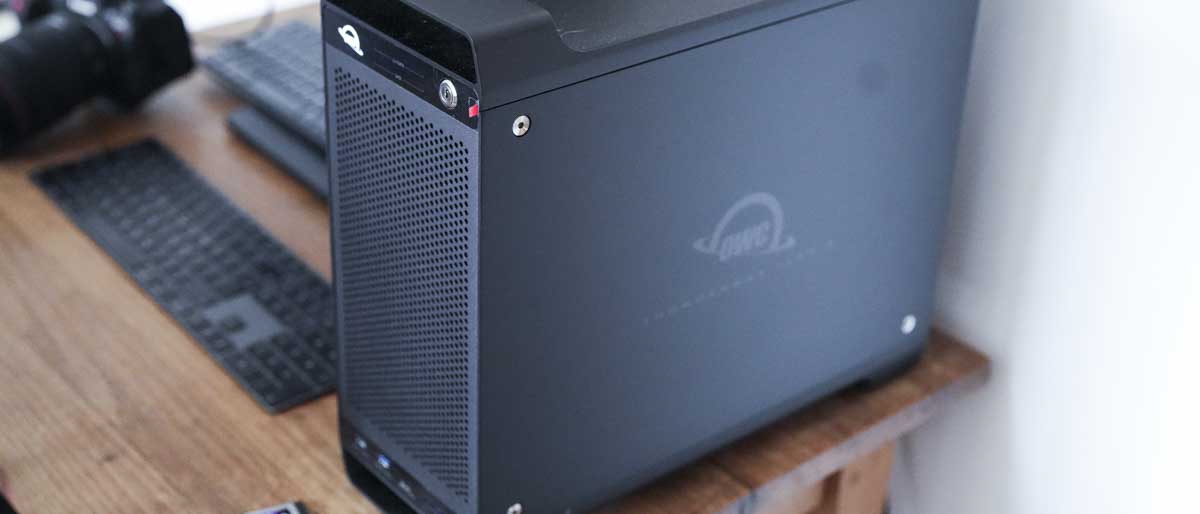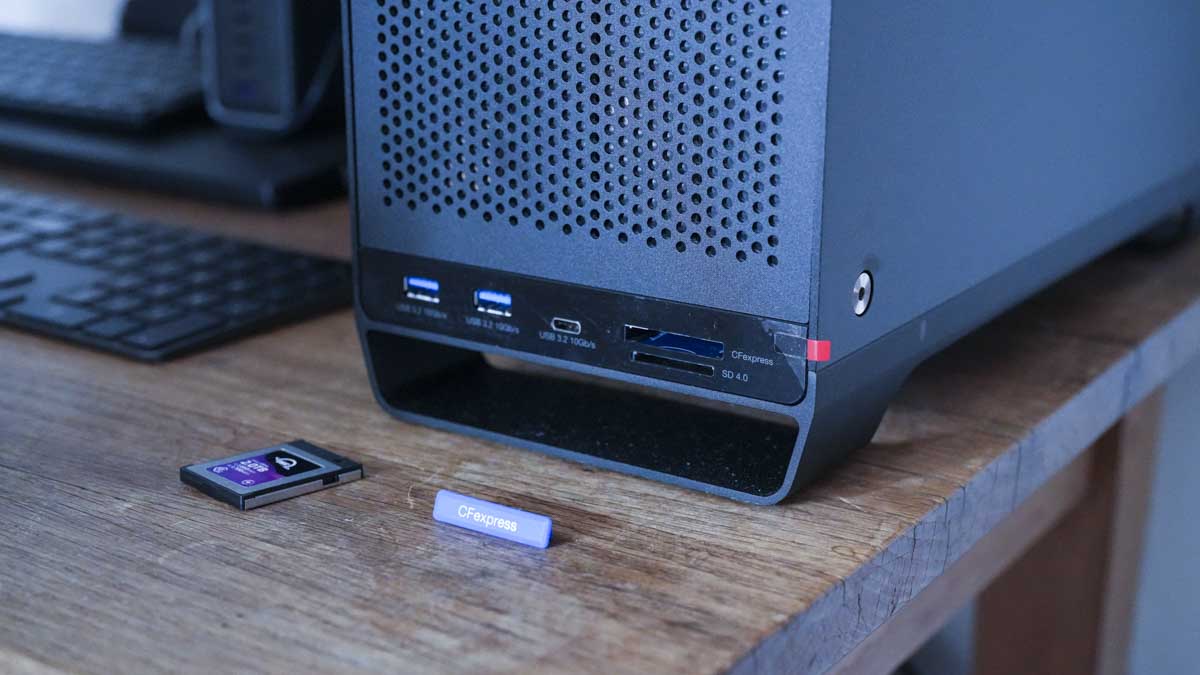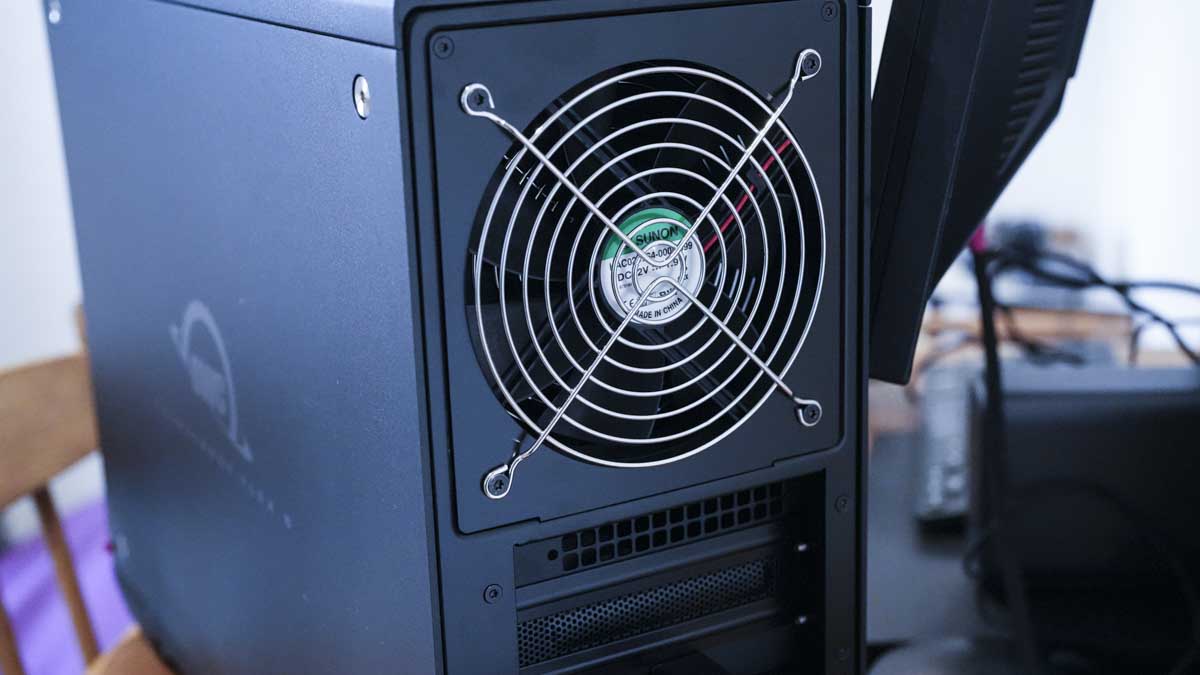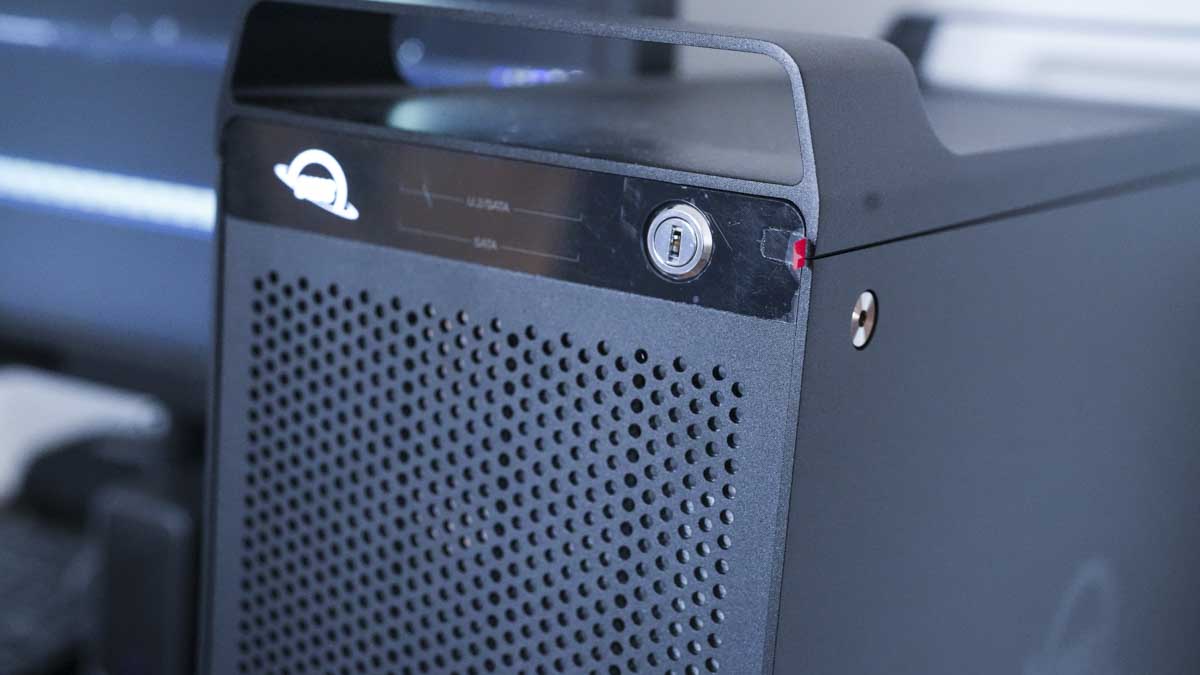
OWC ThunderBay Flex 8: 30-second review
Number of Bays: 8
Mechanisms Supported: 3.5-inch SATA drives, 2.5-inch SATA drives, 2.5-inch U.2 drives (top 4 bays only), NVMe M.2 drives (via U.2 adapter), 2.5 inch SAS drives (requires SAS card, not included), 3.5 inch SAS drives (requires SAS card, not included)
RAID Levels Supported: RAID 0, RAID 1, RAID 0+1, RAID 4, RAID 5, JBOD RAID
Features: Software RAID Expansion Slots: 1 PCIe 3.0 x16 physical, x4 electrical, full-height, half-length, single-width Memory Card Slots: 1 CFexpress 2.0 Type B, 1 SD UHS-II Power Delivery: 2 Thunderbolt 3 Ports (15W, 85W) Device Ports: 1 Host Port - Thunderbolt 3 (USB-C) up to 40 Gb/s, 1 Thunderbolt 3 (USB-C) Port, 1 USB 3.2 Gen 2 Type-C Port up to 10Gb/s, 2 USB 3.2 Gen 2 Type-A Ports up to 10Gb/s, 1 DisplayPort Port Display Support by Port: DisplayPort 1.4: Up to 8K @ 60Hz or 4K @ 120Hz, Thunderbolt 3: Up to 5K @ 60Hz or 4K @ 60Hz
Dimensions: Height: 34.9 cm (13.7 in), Length: 39.0 cm (15.4 in), Width: 14.9 cm (5.9 in)
Weight: 9.2 kg (20.26 lbs)
Working with the latest cameras, both stills and video is an expensive business. OK, the hardware is a known outlay, but then you have to consider the files these cameras produce and where to store them. While larger studios may be well-equipped with IT engineers who will sort out your server rack and storage, in a small photo or video studio, it's usually left to the individual.
That's where the OWC ThunderBay Flex 8 comes into play, as a fully configurable all-in-one storage solution with both the capacity for fast access and archival storage, albeit also fast access. Essentially, the OWC ThunderBay Flex 8 is a RAID-ready enclosure with eight bays for storage media. This media can be configured in any way you like, with a mix of SSD and HDD drives; for example, our review sample shipped with four 2TB SSD drives configured as a Stripe RAID 0 and four 4TB HDDs in RAID 5.
This configuration works on two levels: the first is that the NVMe SSD part gives you fast access, and the HDD part gives you slightly slower access. Then both are configured in RAID so that rather than multiple drives, you just have two, one for fast access and the other to back everything up on. In an ideal scenario, you'd have two more solutions, one NAS with even greater storage kept elsewhere on site and, finally, a cloud storage solution such as Backblaze.
Once the drives are inserted and configured using the OWC SoftRAID 8.0 software, you're set to go. This software must be registered at the time of purchase, and after the initial three years, it can be purchased separately.
In use, the enclosure is incredibly quick, matching the speed of my internal MacBook Pro SSD with ease and enabling the fast, lag-free editing of 4K video in any of the best video editing software. In our tests, Final Cut Pro, DaVinci Resolve, and Premiere Pro, all worked without a glitch. What's really impressive is that over a sustained period, the storage is always ready and data is easy and fast to access. It's also nice that the entire system is so simple; for the complexity of the storage solution that it offers, there really is very little to it.
If you're in the video business and need a solid storage solution for the best video editing PCs, the OWC ThunderBay Flex 8 offers both fast-access working storage and large-scale backup storage. An outstanding choice.
OWC ThunderBay Flex 8: Price & availability

The OWC ThunderBay Flex 8 is widely available and can be purchased as an empty enclosure or configured with the drive configuration that suits your needs. Along with the enclosure, you also receive the superb SoftRAID software, which enables you to configure the drives exactly as needed and in the RAID configuration that best suits your work requirements. This software must be registered at the time of purchase, and after the initial three years, it can be purchased separately.
- Score: 4/5
OWC ThunderBay Flex 8: Design & build

The OWC ThunderBay Flex 8's physical design resembles the compact MacPro 5,1 or the cheese-grater-style Macs that were once commonplace in most video and photo studios. Its robust design facilitates easy lifting and movement, enabling it to be placed on a trolley or packed into a Peli case for transport to shoot locations.
The enclosure, crafted entirely from metal and finished in matte black with a subtle OWC logo, exudes durability and professional quality. It's designed to withstand frequent transportation and use and acquire a characterful patina of scratches and bashes over time, emblematic of its reliability and robust construction.
Externally, the top-right secured access panel allows entry to all the drive bays, accommodating U.2 NVMe drives, M.2 NVMe drives with an adapter, or SATA/SAS drives, offering extensive flexibility. The front panel includes two USB 3.2 Gen 2 Type-A ports and one USB 3.2 Gen 2 Type-C port, all backwards compatible, alongside a CFExpress Type-B card slot compatible with OWC Atlas Ultra and Pro cards.
All these ports and connections make this a very powerful hub that will become core to your computing. One of the nice features of the design is that the Flex 8 can provide 85W of PD to a host computer, such as a MacBook Pro, helping to cut down on cables and additional chargers and packs.
A single kettle-type power cord at the rear negates the need for an adapter. Additional features include a display port for connecting an extra monitor and two Thunderbolt 3 ports, which maximise performance when connected to a computer. To avoid performance issues, it's crucial to use a Thunderbolt cable, not a USB Type-C cable.
The front's perforations and a large rear fan facilitate airflow through the system. The fan noise is noticeable yet easily overshadowed by ambient sounds in a typical workspace setting.
- Score: 4/5
OWC ThunderBay Flex 8: Features
The OWC ThunderBay Flex 8 is engineered for professionals who need storage offering both speed and capacity. It is designed to accommodate various drive types, allowing for a storage capacity of up to 172TB, ideal for large video files, extensive databases, or massive archives. With speeds reaching 2,750MB/s, the device caters to the demands of fast-paced environments such as video editing or content creation, where time is critical. The ability to mix and match drive types enables a balance between speed and capacity.
Advanced RAID support through SoftRAID 8.0 simplifies complex data management, providing robust options for data redundancy and optimised performance. The extensive connectivity options, including Thunderbolt 3, USB-C, and USB-A ports, along with DisplayPort 1.4, transform the Flex 8 into a central hub for multiple devices, displays, and peripherals, supporting up to 8K resolution for detailed and expansive visual workspaces. This emphasises that the ThunderBay Flex 8 can act as a hub for all your creative needs, bringing all your accessories together in a neat and organised manner. The OWC Dock Ejector software further enhances this by enabling an easy and safe way to eject all devices from a machine, saving time and helping to ensure drive integrity.
Further enhancing the ThunderBay Flex 8 are the front SD 4.0 and CFexpress card readers, enabling quick media transfers and immediate access to files. The inclusion of a PCIe slot adds a layer of future-proofing, allowing for additional hardware upgrades or specialised cards to suit evolving professional needs. Some of those hardware upgrades that the PCIe slot enables are the ability to add a video capture card, additional PCIe storage, or additional I/O like USB if desired
As a docking station, the ThunderBay Flex 8 streamlines the workflow, offering an efficient and organised workspace by connecting and powering various devices. Its protective post-production solutions, especially for U.2 NVMe drives, ensure safe and reliable data transport, addressing the challenges faced in many production environments.
- Features: 4.5
OWC ThunderBay Flex 8: Performance

AJA System Test Lite:
HDD Read: 681MB/s, Write: 657MB/s
SSD Read: 2972MB/s, Write: 2797MB/s
CFExpress Read: 809MB/s, Write: 759MB/s
SD Card Read: 244MB/s, Write: 182MB/s
The OWC ThunderBay Flex 8, with its 8TB of SSD storage, has proven highly effective in handling 4K and even 8K video editing in Final Cut Pro and DaVinci Resolve. AJA System Test Lite benchmarks revealed impressive read and write speeds of 2972MB/s and 2797MB/s, respectively, showcasing its capability to support high-resolution video workflows seamlessly when connected to a MacBook Pro M1 16". These speeds are crucial for working with large files typical of 4K and 8K footage, ensuring smooth playback and editing without lag, even with extended timelines.
The ThunderBay Flex 8 serves as reliable storage in integration with editing software like Final Cut Pro X, facilitating real-time editing and color grading. The high-speed NVMe SSDs enable direct work with raw footage, including processor-intensive Log3 formats. Performance limitations stem from the MacBook rather than the transfer speed of the ThunderBay Flex 8. This allows for efficient handling of footage from various cameras in different formats, enabling faster overall workflow through multiple conversions and renders.
While the HDD speeds are slower than those of the SSDs, they still deliver a respectable 861MB/s. This is suitable for 4K video editing and ideal for backup storage due to the lower cost per capacity. The HDDs' RAID 5 configuration ensures data safety, allowing for easy replacement of a drive without data loss.
The ThunderBay Flex 8 also shines as a connectivity hub, integrating devices like 4K monitors, control consoles, and memory cards into a cohesive editing suite. However, the lack of an HDMI port (Although an adapter can, of course, be used) and a front-facing Thunderbolt port slightly limits connection options, which, while not a significant issue, is notable.
The unit's fan noise is present but not overly disruptive, and it can be mitigated by placing it under a desk. However, the acoustic design could be improved for quieter operation. An informational screen for monitoring system health and power draw would be beneficial, especially for on-location shoots where power management is crucial. During testing, the ThunderBay Flex 8 was connected to a Bluetti AC200 power station, and while the average power draw could be calculated, having real-time data would enhance usability.
The OWC ThunderBay Flex 8 stands out for its high-speed data handling and comprehensive storage solutions. It proves to be a valuable asset in professional video editing environments. The combination of working and backup storage in the same unit, coupled with the SoftRAID software for swift monitoring, makes it an impressive solution.
One of the most impressive points is the simplicity of the all-in-one approach. It's a RAID-configured system optimised for speed, making it an ideal platform for video editing. On the other hand, it's a mass storage device with huge capacity potential that's ideal for backing up all your video projects, again in RAID so everything is kept safe. The Flex 8 is also offered as a hardware RAID for users who require a hardware rather than software RAID solution.
If the working drive with fast data access and storage capacity wasn't enough, it also enables you to use it as the hub of your workstation so everything connects, centralising your resources and making life extremely easy. there are small ways that you could see this expand for greater flexibility with more users in a production workflow. Still, with shared drives and AirDrop, this system works impressively well, and when integrated into a larger backup solution, in reality, there really is little here to fault.
- Performance: 5/5
Should you buy the OWC ThunderBay Flex 8?
If you are a professional requiring high-speed, high-capacity storage for tasks like 4K or 8K video editing, the answer is a resounding yes. Its ability to mix and match drive types and configurations, coupled with robust RAID support and extensive connectivity, makes it an ideal choice for those needing a versatile, reliable storage solution. However, for users with less demanding storage needs or tighter budgets, it may be worth considering less expensive alternatives that still meet their performance requirements.

Buy it if...
Don't buy it if...
We tested the best business computers - and here are the ones we rate







